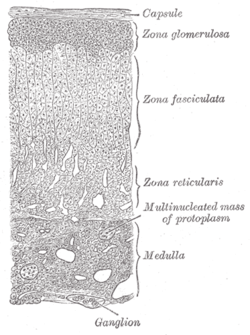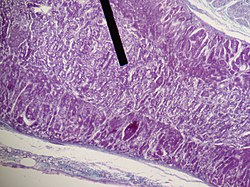The adrenal medulla
Adrenal gland[edit | edit source]
The adrenal gland or suprarenal gland is a small paired organ situated above kidneys resembling caps shape structures surrounded by adipose tissue. The adrenal gland divides into the outer adrenal cortex and the inner adrenal medulla.
Adrenal cortex[edit | edit source]
- Zona Glomerulosa: is the outermost layer of the cortex specialized in the production and secretion of minerocorticoids and predominantly aldosterone.
- Zona Fasciculata: is the intermediate layer of the cortex specialized in the production and secretion of glucocorticoids and predominantly cortisol and corticosterone.
- Zona Reticularis: is the innermost layer of the cortex specialized in the production and secretion of sex steroid hormones and predominantly androgens and androgen precursors.
Adrenal medulla[edit | edit source]
Functional anatomy of adrenal medulla[edit | edit source]
- The adrenal medulla is located at the center of the adrenal gland, being the innermost part surrounded by the adrenal cortex. It resembles literally a large sympathetic ganglion.
- It consists of cells called chromaffin cells which produce and secrete, upon stimulation, catecholamines; epinephrine, norepinephrine and dopamine. The chromaffin cells are modified postganglionic neurones, that have lost their dendrites and axons, receiving sympathetic innervation and stimulation by preganglionic autonomic fibers controlled by the CNS. The chromaffin cells have neuronal properties due to their embryonic-neural crest origin which is different from that of adrenal cortical cells. Thus the adrenal gland is referred as an endocrine gland of dual origin just like hypothalamus.
- The chromaffin cells form clusters around large and numerous blood vessels a feature that enhances the efficiency amd the velocity of the catecholamine activity. The medullary cells are considered as endocrine cells but in reality they exhibit neuroendocrine properties due to the neural origin of the adrenal medulla.
- The amount of dopamine secreted by the medulla is relatively small in comparison to the total body dopamine. It is used, however, as a precursor for the production of norepinephirne and eventually epinephrine. The most abundant catecholamine released by the medulla is epinephrine whose amount is five times greater than that of norepinephrine constituting the 80% of total catecholamine amount.
Synthesis of catecholamines[edit | edit source]
- The catecholamine hormones are synthesized from the amino acid L-tyrosine. The L-tyrosine is transformed to L-DOPA in presence of the tyrosine hydroxylase enzyme which is the rate limiting enzyme of the whole catecholamine synthetic pathway. The L-DOPA in turn is transformed into dopamine in presence of the DOPA decarboxylase enzyme. The dopamine is transformed into norepinephrine in presence of the dopamine ß-hydroxylase. The norepinephrine is transformed eventually into epinephrine in presence of the N-methyltransferase enzyme.
- Sympathetic stimulation induces increased concentrations of both tyrosine hydrolase and dopamine ß-hydroxylase. The hypothalamic CRH (corticotropin releasing hormone) and the hypophyseal ACTH(adrenocorticotropic hormone) help to sustain the levels of these enzymes under stressful conditions. At the same time, cortisol induces the N-methyltransferase and therefore selectively stimulates epinephrine synthesis.
Metabolism of catecholamines[edit | edit source]
The circulating medullary catecholamines perform similar activity as the sympathetic neurotransmitter norepinephrine having one big characteristic difference. The half life of the circulating medullary catecholamines is only few minutes a time much smaller than that of the sympathetic norepinephrine resulting to a lesser functional efficiency. This results from the presence of two enzymes within the blood circulation that degrade the medullary catecholaminess very fast.They can be degraded either by deamination by the enzyme monoamine oxidase (MAO) or by methylation by the enzyme catechol-O-methyltransferase (COMT).
Links[edit | edit source]
Bibliography[edit | edit source]
- HALL, John E. – GUYTON, Arthur C. Guyton and Hall Textbook of Medical Physiology. 12. edition. Saunders/Elsevier, 2010. ISBN 1416045740.
- Lecture Notes: Prof. MUDr. Jaroslav Pokorný DrSc.


